
DOWN BUT NOT OUT
Columbus' core looking for life after office hours
Fringe areas vital, but state capital's center frays
6/25/2008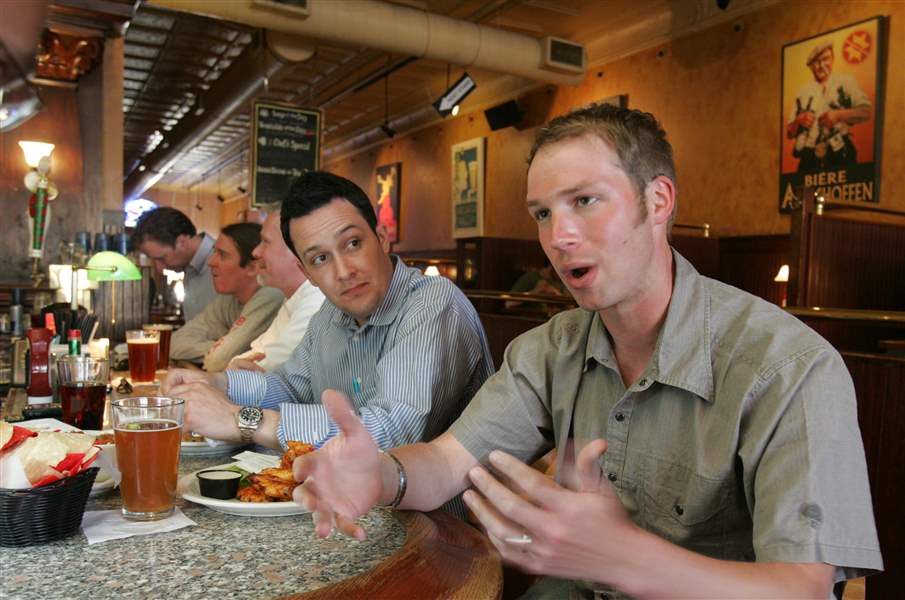
Tim Morgan of Washington, left, listens as Wes Meermans lists the finer points of his Columbus neighborhoods: German Village, where he resides, and Short North, where he goes to play
The Blade/Lori King
Buy This Image
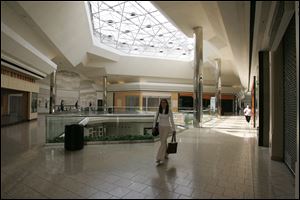
Allison Mattey often visits City Center in downtown Columbus, but only to use it as a shorter route to her parked car.
COLUMBUS -- As 26-year-old Wes Meermans enjoyed a beer after work at a watering hole in downtown's Historic North Market District, he ruminated on the city he adopted as home four years ago.
"It's almost like the San Francisco of the Midwest," said the Internet marketing executive. "It's the most young, progressive city in Ohio, with a lot of professional opportunities."
Such sentiments are commonplace in the young, hip neighborhoods like Short North and German Village that surround downtown Columbus.
With a nearly recession-proof economy that includes 15,400 state employees, Ohio's capital city and its downtown are better positioned than most places across the state to ride out the nation's economic slump.
Yet beyond the civic pride and the happening fringe neighborhoods, downtown Columbus has a side that isn't mentioned in tourist brochures.
READ MORE: Down But Not Out series
The area around the Statehouse and other corners of the downtown core are struggling. After office towers empty at 5 p.m., "you can hear a pin drop" on most days, locals joke. Restaurant choices are limited.
The national real estate crash has slowed condo creation, which held promise of helping revive the area.
The Columbus City Center Mall is a ghost town whose future is being debated in the metro area of 1.6 million people.
"It's sad," muttered a middle-age downtown worker who uses the nearly empty shopping center as a shortcut to her car.
As Barry Manilow's 1974 hit "Mandy" played over loudspeakers, a handful of customers walked through the few remaining shops and fast-food places.
"When I moved here two years ago, shops were closing daily," said Allison Mattey, a student and part-time paralegal. "This is basically vacant," she added, surveying the scene.
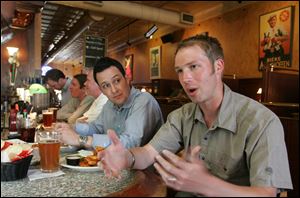
Tim Morgan of Washington, left, listens as Wes Meermans lists the finer points of his Columbus neighborhoods: German Village, where he resides, and Short North, where he goes to play
She suspects that the mall fell victim to competition from new shopping centers in the suburbs. Whatever the reason, store closings at City Center Mall left few places to shop downtown, Ms. Mattey said.
Some Columbus residents trace the area's decline to the opening eight years ago of Nationwide Arena, host to Columbus Blue Jackets National Hockey League games and other events. The surrounding Arena District, a mile north of the downtown center, has drawn activity away from the Statehouse area, they complain.
Others say the deterioration began long before the arena was built in 2000 for $150 million by hometown company Nationwide Insurance.
The size and reach of downtown, which occupies 2.2 square miles and is touted as one of the biggest downtowns in the nation, complicates restoration efforts, say some people who work there.
"It needs serious work," Ian Boyland, manager of Barley's Brewing Co. in the North Market District, said of the city core.
Events at the restored Ohio Theater and other venues help draw people some nights, he noted. Otherwise, "there's no reason to go down there," Mr. Boyland said.
Moving downtown
The area has received a boost from people moving downtown. More than 2,800 apartments and condos were created or started between 2002 and 2006 in downtown, the Short North, and German Village, according to a study by Danter Co., a Columbus real estate consultant. Projects include the former Seneca Hotel, which was converted to 77 apartment units.
The downtown population, which stood at 6,200 in 2000, has been climbing gradually after plummeting for three decades, said boosters, who said they aren't sure of the exact count now.
Condo developers include Jack Hoopes of Columbus' Spectrum Properties, who hit two home runs before his current project. Buyers led by young professionals and empty nesters snapped up 120 units in six months in the earlier complexes.
But at Cityview at Third, 21 of the 48 units, priced from $220,000 to $325,000, were unsold a year after completion.
Mr. Hoopes has no plans to build more condos soon. "The market is going to have to get better," he said.
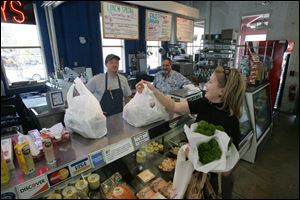
Susan Eskin shops at The Fish Guys store inside North Market, a more successful version of the Erie Street Market in Toledo.
Said Greg Thomas, a sales agent with CB Richard Ellis in downtown Columbus: "Residential in downtown is hurting very bad right now."
Mr. Hoopes said costs of buying and renovating vintage buildings downtown is too high to allow him to sell condos at $150,000 to $200,000, as many activists want.
Similarly, he has looked at a few buildings in downtown Toledo but concluded the market wasn't strong enough to allow him to turn a profit.
Downtown rehabilitation efforts in Columbus aren't jeopardized by the real estate crash, insisted Bill Webster, economic development administrator.
'It's cyclical'
"It's cyclical, but over time it will be fine," he said of downtown housing.
Developers have pumped $2 billion into downtown condos, apartments, and office buildings since 2003, he added. "We've gone from little residential to 5,000 condos or apartments units built or in the pipeline."
And he predicted that retailers will return as more people move to the city core.
One sign of downtown progress, he asserted, is the falling office vacancy rate. Once above 20 percent, it improved to 14 percent by the end of last year, according to estimates from CB Richard Ellis. With 10.5 million square feet - equal to Toledo's 32-story Fifth Third Center at One SeaGate tower copied 15 times - downtown Columbus has nearly twice as much space as downtown Toledo.

Officials say the vacancy decline is attributed to two factors: job creation and conversion of lower-end office buildings into housing.
City officials say they have attracted 2,200 jobs to the city core during the past five years through a program that returns half of municipal income taxes paid to employers relocating downtown. The municipal officials' estimate contrasts with U.S. Census Bureau reports showing that private-sector employment in the downtown improvement districts, established by merchants under Ohio law, fell by 12,000, to 62,761 between 2000 and 2005. But the Census report doesn't include government employees, who make up a large share of workers in downtown Columbus.
It is unclear how many people government agencies employ downtown. In metro Columbus overall, there are 158,000 government employees in a workforce of 946,000, according to the U.S. Labor Department.
Businesses fall slightly
And, although the Census Bureau reports a 16 percent decline in employment downtown during the five-year period, it said the number of businesses has dropped only 2 percent to 2,700. That could mean that the work force losses were caused by personnel cuts more than by company flight.
The nonprofit Columbus Downtown Development Corp. counts 100,000 downtown workers, including government employees.
Several projects are in the works to make downtown more attractive to businesses and residents. They include a new minor-league baseball field to be ready next year near Nationwide Arena; a proposed $103 million streetcar line that would connect downtown to the campus of Ohio State University, and a mile-long downtown park connected to the Scioto River.
The abandoned Lazarus Department Store was converted to offices and retail space at a cost of $80 million in a project completed this year. Nearly all offices are full, many with state of Ohio employees. Storefronts on the ground floor have not been leased, however.
Ken Danter, a real estate consultant who has studied housing in downtown Columbus, predicted that condos and apartments will continue to fuel downtown revitalization.
And not all construction has been in downtown fringe neighborhoods, he said. The Arena District, a 95-acre collection of shops and restaurants adjoining Short North that once housed the Ohio Penitentiary, has received about 200 apartments and condos in recent years.
And although the area around the Statehouse is quiet after offices empty, nearby neighborhoods buzz with activity.
Short North is among the city's hottest neighborhoods.
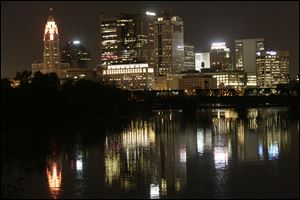
Columbus’ skyline is bright at night, but most people have gone home from their day jobs.
'A very livable city'
Mr. Meermans, the Internet marketing executive, lives in nearby German Village, often bicycles to work downtown, and socializes in the cafes and restaurants of Short North.
"Columbus is a very livable city," said the 2004 Ohio University graduate.
More than a million people a year patronize North Market, off Spruce Street near North High Street. A larger - and more successful - version of downtown Toledo's Erie Street Market, North Market is operating subsidy-free for the first time this year after receiving about $22,000 from the city annually for years, city officials say.
Angelo Edwards quit his job as a mail handler with the U.S. Postal Service to operate a fish market in the giant food-and-gift bazaar close to Short North.
"We do fairly decent," he said. "Sales are down from two years ago. Some people are watching their money. But most people who live in this area are pretty affluent."
Susan Eskin, a retired computer software executive, was shopping for fish to serve at a Kentucky Derby party for 70. She and her husband, a physician, live in suburban New Albany.
"We're downtown a couple times a week at least," she said. "We have friends who are moving downtown from the suburbs. It's thriving."